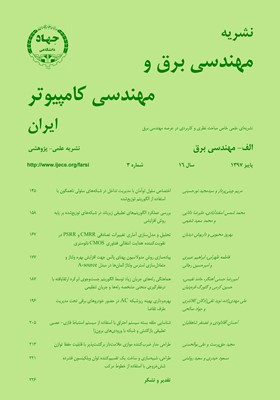بررسی عملکرد الگوریتمهای تطبیقی زیرباند در شبکههای توزیعشده بر پایه روش افزایشی
محورهای موضوعی : مهندسی برق و کامپیوترمحمد شمس اسفند آبادی 1 , علیرضا دانایی 2 , محمدسعید شفیعی 3
1 - دانشگاه شهید رجایی
2 - دانشگاه تربیت دبیر شهید رجایی
3 - دانشگاه تربیت دبیر شهید رجایی
کلید واژه: الگوریتم تطبیقیخطای میانگین مربعروش افزایشیشبکه توزیعشده,
چکیده مقاله :
این تحقیق به ارائه مسئله تخمین توزیعشده در یک شبکه افزایشی بر اساس الگوریتمهای خانواده زیرباند نرمالیزهشده (NSAAs) پرداخته است و الگوریتمهای زیرباند نرمالیزهشده توزیعشده (dNSAA)، زیرباند نرمالیزهشده توزیعشده با انتخاب جزئی ضرایب (dSPU-NSAA)، زیرباند نرمالیزهشده توزیعشده با انتخاب پویای زیرباندها (dDS-NSAA) و زیرباند نرمالیزهشده توزیعشده با انتخاب جزئی ضرایب و انتخاب پویای زیرباندها (dSPU-DS-NSAA) را در یک قالب واحد معرفی میکند. الگوریتم زیرباند نرمالیزهشده توزیعشده تطبیقی نسبت به الگوریتم حداقل میانگین مربعات نرمالیزهشده توزیعشده تطبیقی (dNLMS)، دارای عملکرد بهتری از لحاظ سرعت همگرایی در مواجهه با ورودیهای رنگی در گرهها است. در مقایسه با (dNSAA)، الگوریتمهای (dSPU-NSAA) و (dDS-NSAA)، علیرغم عملکردی مشابه دارای پیچیدگی محاسباتی کمتری هستند. همچنین با ترکیب این دو الگوریتم، الگوریتم (dSPU-DS-NSAA) برقرار میشود که از لحاظ پیچیدگی محاسباتی کاهش بیشتری دارد. به علاوه، یک روش واحد برای تحلیل تئوری عملکرد میانگین مربعات برای هر گره ارائه شده و روابط جامعی برای بررسی عملکرد حالت گذرا، ماندگار و باند پایداری برای الگوریتمهای نوین توزیعشده به دست میآید. با انجام شبیهسازیهای مختلف در شبکههای توزیعشده، عملکرد مناسب این الگوریتمها و صحت روابط تئوری حاصلشده مورد بررسی قرار گرفته است.
This paper presents the problem of distributed estimation in an incremental network based on the family of normalized subband adaptive algorithms (NSAAs). The distributed NSAA (dNSAA), the distributed selective partial update NSAA (dSPU-NSAA), the distributed dynamic selection NSAA (dDS-NSAA), and the dSPU-DS-NSAA are introduced in a unified way. The dNSAAs have better convergence speed than distributed normalized least mean square (dNLMS) algorithm especially for colored Gaussian input of the nodes. In comparison with dNSAA, the dSPU-NSAA, and dDS-NSAA have lower computational complexity and close performance to dNSAA. Also by combination of these algorithms, the dSPU-DS-NSAA is established which is computationally efficient. In addition, a unified approach for mean-square performance analysis of each individual node is presented. This approach can be used to establish a performance analysis of classical distributed adaptive algorithms as well. The theoretical expressions for transient, and steady-state performance analysis of the various dNSAAs are introduced. The validity of the theoretical results, and the good performance of these algorithms are demonstrated by several computer simulations.
[1] I. Akyildiz, W. Su, Y. Sankarasubramaniam, and E. Cayirci, "A survey on sensor networks," IEEE Communications Magazine, vol. 40, no. 8, pp. 102-114, Aug. 2002.
[2] D. Li, K. D. Wong, Y. H. Hu, and A. M. Sayeed, "Detection, classification, and tracking of targets," IEEE Signal Processing Magazine, vol. 19, no. 2, pp. 17-29, Mar. 2002.
[3] C. G. Lopes and A. H. Sayed, "Incremental adaptive strategies over distributed networks," IEEE Trans. Signal Processing, vol. 55, no. 8, pp. 4064-4077, Aug. 2007.
[4] L. Li, J. A. Chambers, C. G. Lopes, and A. H. Sayed, "Distributed estimation over an adaptive incremental network based on the affine projection algorithm," IEEE Trans. Signal Processing, vol. 58, no. 1, pp. 151-164, Jan. 2010.
[5] M. S. E. Abadi and A. R. Danaee, "Low computational complexity family of affine projection algorithms over adaptive distributed incremental networks," AEU-International J. of Electronics and Communications, vol. 68, no. 2, pp. 97-110, Feb. 2014.
[6] M. de Courville and P. Duhamel, "Adaptive filtering in subbands using a weighted criterion," IEEE Trans. Signal Processing, vol. 46, no. 9, pp. 2359-2371, Sept. 1998.
[7] J. J. Shynk, "Frequency domain and multirate adaptive filtering," IEEE Signal Processing Magazine, vol. 9, no. 1, pp. 14-37, Jan. 1992.
[8] K. A. Lee and W. S. Gan, "Improving convergence of the NLMS algorithm using constrained subband updates," IEEE Signal Processing Letters, vol. 11, no. 9, pp. 736-739, Sept. 2004.
[9] M. S. E. Abadi and J. H. Husøy, "Selective partial update and set-membership subband adaptive filters," Signal Processing, vol. 88, no. 10, pp. 2463-2471, Oct. 2008.
[10] S. E. Kim, Y. S. Choi, M. K. Song, and W. J. Song, "A subband adaptive filtering algorithm employing dynamic selection of subband filters," IEEE Signal Processing Letters, vol. 17, no. 3, pp. 245-248, Mar. 2010.
[11] S. Haykin, Adaptive Filter Theory, NJ: Prentice-Hall, 4th Edition, 2002.
[12] H. C. Shin and A. H. Sayed, "Mean-square performance of a family of affine projection algorithms," IEEE Trans. Signal Processing, vol. 52, no. 1, pp. 90-102, Jan. 2004.
[13] D. E. Knuth, Sorting and Searching vol. 3 of the Art of Computer Programming, 2nd Ed. Reading, MA: Addison-Wesley, 1973.
[14] H. Malvar, Signal Processing with Lapped Transforms, Artech House, 1992.


